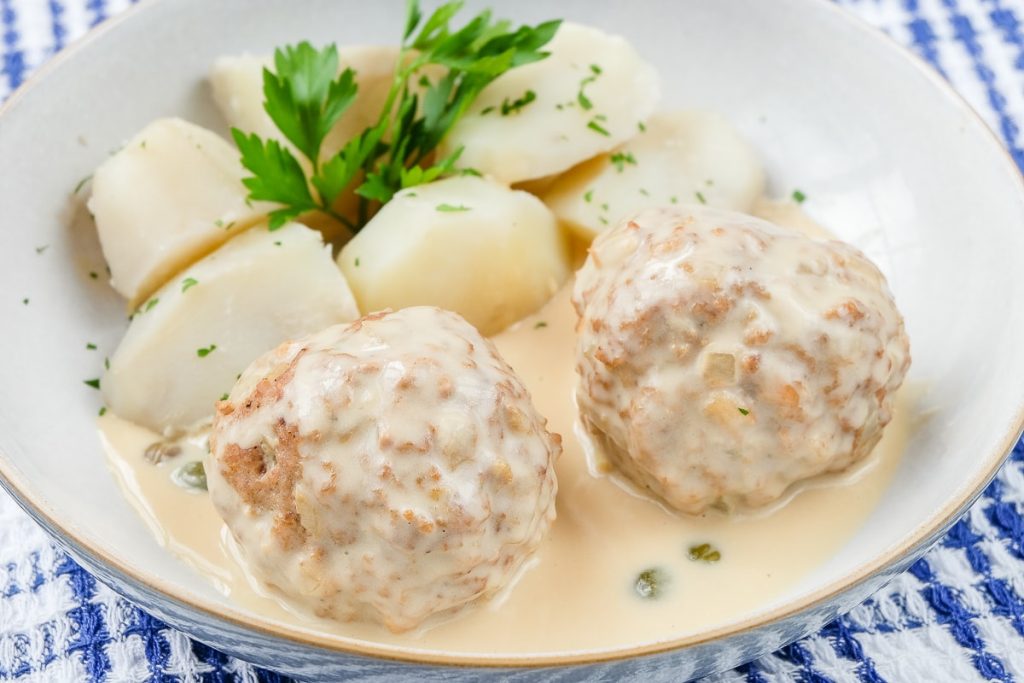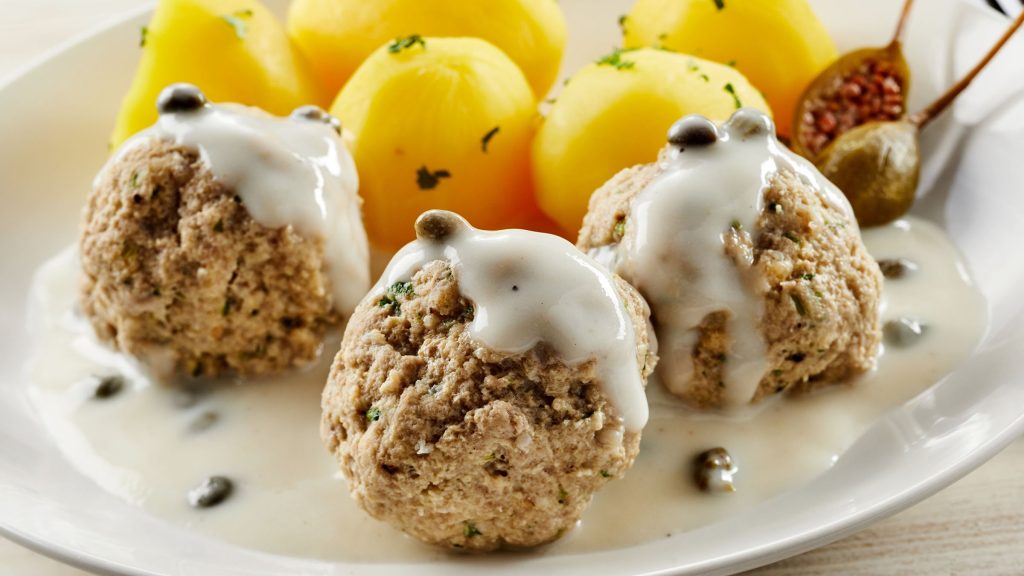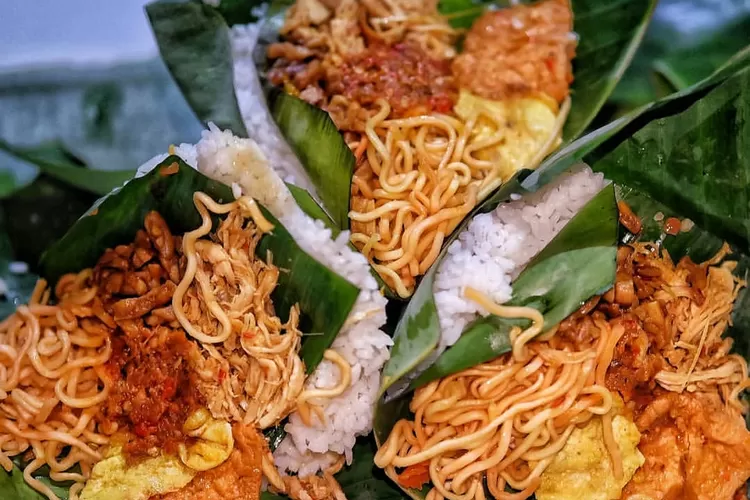Indulging in the world of German cuisine is like embarking on a delightful journey through flavors that have withstood the test of time. Among these culinary treasures, there’s a dish that stands out not only for its unique name but also for its delectable taste and intriguing history. Picture this: tender meatballs bathed in a velvety white sauce infused with tangy capers and the zest of fresh lemon. Welcome to the enchanting world of Königsberger Klopse, where each bite is a harmonious symphony of flavors that speaks volumes about German comfort food and culinary tradition.
Königsberger Klopse : A Palate-Pleasing Experience of German Culinary Tradition

German cuisine is a journey through flavors that have stood the test of time, each dish telling a story of cultural heritage and regional pride. Among these treasured culinary delights is the Königsberger Klopse, a dish that encapsulates the essence of German comfort food. Bursting with flavors and a history as rich as its taste, Königsberger Klopse is a dish that invites both locals and visitors to savor its delectable combination of flavors and embrace a taste of tradition.
A Royal Origin
Königsberger Klopse, often lovingly referred to as “Königsberger meatballs,” originated in the city of Königsberg, which is now known as Kaliningrad in Russia. The dish gained popularity during the 18th century and has since become a beloved part of German culinary heritage. Legend has it that Königsberger Klopse was a favorite of Frederick the Great, the King of Prussia, giving it a royal connection that adds to its allure.
A Culinary Symphony
At the heart of Königsberger Klopse are tender meatballs, traditionally made from a mixture of ground veal and pork, though variations using beef or even fish are not uncommon. The meat is seasoned with a delicate blend of herbs and spices, including parsley, nutmeg, and white pepper. The magic, however, lies in the velvety white sauce that envelops the meatballs, creating a harmonious symphony of flavors. The sauce is crafted using a roux base, with capers, lemon zest, and a splash of tart white wine or vinegar, resulting in a tangy yet creamy finish.

A Hearty Accompaniment
Königsberger Klopse are traditionally served with a side of boiled potatoes or buttered egg noodles, providing a hearty and satisfying meal that warms the soul. The mild flavors of the meatballs and the robustness of the sauce create a balance that speaks to both comfort and culinary finesse.
Culinary Heritage Reimagined
While the traditional recipe remains beloved, modern interpretations of Königsberger Klopse have emerged, catering to different tastes and dietary preferences. Chefs have experimented with variations such as vegetarian versions made from mushrooms or tofu, ensuring that the dish continues to evolve while honoring its roots.
Also read : 7 Best Hotels on Rügen Island for an Idyllic Coastal Stay in Germany
A Culinary Adventure
For travelers seeking an authentic taste of Germany, Königsberger Klopse presents an opportunity to explore the nation’s culinary landscape beyond the well-known sausages and pretzels. Many restaurants throughout Germany offer this dish on their menus, allowing visitors to embark on a gastronomic adventure that connects them to the country’s history and culture.
Flavorful History of Königsberger Klopse: From Royalty to Culinary Tradition

In the realm of German culinary heritage, few dishes can claim a history as rich and intriguing as that of Königsberger Klopse. These delectable meatballs swimming in a tangy white sauce are not just a feast for the taste buds; they also carry with them a fascinating tale that weaves together royal origins, cultural evolution, and the art of gastronomy. Join us as we delve into the past and uncover the flavorful history that has made Königsberger Klopse a beloved staple of German cuisine.
A Royal Affair
The story of Königsberger Klopse begins in the historic city of Königsberg, now known as Kaliningrad, Russia. It’s believed that this dish was a favorite of none other than Frederick the Great, the King of Prussia during the 18th century. The king’s fondness for these meatballs contributed to their popularity, giving rise to the dish’s royal association. This royal connection not only elevated Königsberger Klopse’s status but also added an air of sophistication to its humble ingredients.
The Culinary Evolution
Originally made with a mixture of veal and pork, the meatballs were seasoned with a delicate blend of herbs and spices, including parsley, nutmeg, and white pepper. However, it was the distinctive white sauce that truly set Königsberger Klopse apart. Crafted from a roux base, the sauce featured capers and the zest of fresh lemon, lending the dish its signature tangy and creamy flavor profile.
Adaptations and Variations
As with any beloved culinary tradition, Königsberger Klopse has evolved over the years. While the classic recipe remains cherished, chefs and home cooks have explored adaptations to cater to changing tastes and dietary preferences. Some versions incorporate different types of meat, such as beef or fish, while others offer vegetarian alternatives using mushrooms or tofu. These variations not only add diversity to the dish but also showcase the culinary creativity of different regions and generations.
Also read : 7 Exotic Tropical Destinations for Your Dream Getaway
Cultural Symbolism
Beyond its delightful taste, Königsberger Klopse symbolizes the cultural heritage and regional pride of Germany. It’s a dish that bridges the gap between the past and the present, reminding us of the days when Königsberg was a bustling city and Frederick the Great was its reigning monarch. With every bite, diners savor not only the flavors but also the stories embedded within this culinary masterpiece.
A Taste of Tradition
Today, Königsberger Klopse continues to grace tables across Germany and beyond, offering a taste of tradition that transcends time. Whether enjoyed in a cozy family setting, a traditional German inn, or a modern restaurant, each serving of Königsberger Klopse is a testament to the enduring legacy of German culinary history.
Conclusion
Königsberger Klopse is more than just a dish; it’s a link between the past and the present, a tribute to a king’s palate and a testament to the evolution of gastronomy. With each bite, you’re not only savoring the delicate balance of flavors but also connecting with the culinary journey that spans centuries. From royal tables to contemporary kitchens, Königsberger Klopse remains a symbol of German culinary heritage, inviting us to embrace tradition and savor the stories that have shaped its delectable history.
Königsberger Klopse is more than just a dish; it’s a journey through time that encapsulates the flavors of generations past. This culinary delight pays homage to tradition while embracing innovation, making it a timeless favorite that spans eras and tastes. Whether you’re savoring it in a cozy German inn or trying your hand at cooking it at home, Königsberger Klopse promises a palate-pleasing experience that highlights the heart and soul of German culinary heritage.

Muhammad Bing Keulana is a prominent traveler and writer who spent a lifetime exploring the world and documenting his experiences. He is a true adventurer, always seeking out new and exciting experiences. His love for exploration is matched only by his passion for writing







